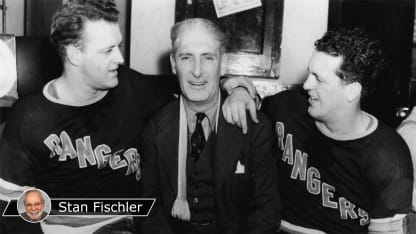Legendary hockey reporter Stan Fischler writes a weekly scrapbook for NHL.com. Fischler, known as "The Hockey Maven," shares his humor and insight with readers each Wednesday.
This week, with NHL training camps underway, Fischler looks back 96 years to the New York Rangers first training camp and a managerial tug of war as the they prepared for the 1926-27 season.
Rangers had tumultuous first training camp in 1926
Smythe put together strong team, was 'shattered' to be replaced by Patrick

By
Stan Fischler
Special to NHL.com
Few teams in NHL history endured a more turbulent first training camp than the New York Rangers in 1926. A power struggle at the very top of the organization was the culprit.
Colonel John Hammond, president of Madison Square Garden, was given charge of the Rangers when they were officially admitted to the NHL in March of 1926. The Colonel's first order of business was to find someone to put a team together. Hammond needed help, so he turned to Charles Adams whose Boston Bruins already were in the League.
"There's a fellow called [Conn] Smythe in Toronto who brings in college teams that are about as good as mine," advised Adams. "Why don't you give him a try?"
Hammond contacted the notoriously temperamental Smythe and offered him a multi-year deal at a $10,000 salary plus expenses.
"It was the chance to move into big time hockey that I had been waiting for," Smythe revealed in his autobiography. "Now I had to go out and find him a team. It would be a club that I also would manage."
Smythe was loaded with contacts and knew every player in the seven-team NHL, but his competition was keen. Not only did New York already have a club playing at the Garden, the Americans, but new franchises also had been granted to Detroit and Chicago.
"The edge I had," said Smythe, "was that I'd been coaching amateur hockey, watching men on the way up. Some I knew were good enough for the NHL."
Thanks to Smythe's savvy and recruiting hustle, one by one the infant Rangers roster grew. The first to sign was goalie Lorne Chabot, followed by defensemen Ching Johnson and Taffy Abel. For scoring, the Rangers signed brother, Bill and Bun Cook, who previously starred for the defunct Saskatoon team.
Bill Cook recommended a Vancouver center named Frank Boucher, who eventually would play with the Cooks on one of the best lines in NHL history. Skill-wise, New York's second unit -- Murray Murdoch, Paul Thompson and Billy Boyd -- was above the NHL average. Murdoch emerged as the NHL's "iron man," never missing a Rangers game for 11 seasons.
The price the Rangers paid for the entire lineup -- sprinkled with no less than four future Hall of Famers -- was $32,000.
"I hired two complete teams, one for the Rangers and one for their farm team at Springfield which went on to win American League championships," Smythe said.
Considering the affordable price, Colonel Hammond should have been ecstatic. Instead, the Garden's boss was furious. Several friends had told him that his new team would fail miserably and that Smythe was signing too many amateurs. One pal told the Colonel that the Rangers needed a big scorer named Babe Dye who had been made available by the Toronto St. Pats. Hammond wanted such a star. Smythe emphatically did not.
"Conn," asserted Hammond, "we can't start the season with a bunch of rank amateurs like this."
Smythe knew all about Dye but Hammond had only heard about Babe and, therein, was the cause of their tug-of-war.
"Toronto offered Dye to me," Smythe remembered, "and I turned it down. He wasn't my kind of player -- too much the individualist and not enough of a team man. Hammond phoned me and practically ordered me to sign Dye and I refused. Babe was sold to Chicago and by mid-October I had the Rangers working out at Ravina Gardens in West Toronto."
What Smythe didn't know was that the irate Hammond had wired former star player and later hockey manager in Vancouver, Lester Patrick. The Colonel offered Patrick the Rangers coaching job and a train ticket to Manhattan for a meeting at Madison Square Garden.
Patrick arrived, signed a contract for a staggering $18,000 a year and then boarded a train to Toronto accompanied by the Colonel.
Hammond also told Smythe to meet him at Toronto's Union Station. After the New York Central Express pulled in and discharged its passengers, Smythe found himself greeting Hammond and his own replacement.
"To say I was shattered," Smythe recalled, "is putting it mildly. Had I been a politician, I'd have stuck with the Rangers, but I was no politician."
After the shock of the unexpected managerial-coaching change dissipated, the Rangers regrouped. And, as Smythe predicted, the Rangers not only were competitive but finished first in the American Division. In only their second year, the Smythe-picked, Patrick-coached Rangers won the Stanley Cup in 1927-28.
"Losing the Rangers job was a blessing," Smythe admitted. "Lester Patrick did a better job in New York than I ever could have done. And, as for Colonel Hammond, he did me a favor by firing me!"
Smythe was hired by the Toronto Maple Leafs and the team he put together won the Stanley Cup in 1932.
So, his firing was a win-win situation for the Rangers and Maple Leafs. Even though it created a tumultuous first training camp for the expansion Rangers.

















